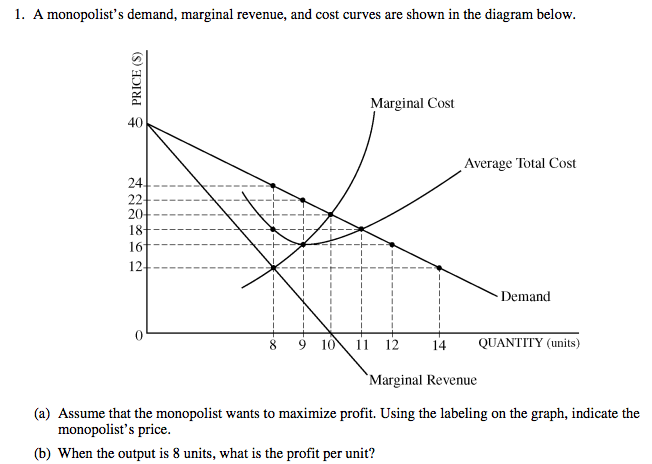Monopoly 2 - Profit Max
1995 AP Microeconomics Exam
Answer (D) Less than the socially optimal level, since the price paid by consumers exceeds the firms marginal cost. (To answer this question you must know what a profit maximizing monopoly firm actually looks like, and what the socially optimal level is.(Discuss Later))
Just like a perfectly competitive firm a monopolistic company wants to produce where profit maximization occurs. (Profit Max is where MR = MC)
First, find the Profit Max, where MR and MC intersect, draw a dotted line straight up until you bounce off of the Demand (price) curve and continue until your line bumps into the Price axis. This is your Profit Max price. Go back to where MR and MC intersect and draw a dotted line down to the output axis. This will be the amount of product that will be produced (Output) at that price. Notice, in the graph above the section of the ATC curve (where it intersects with the dotted line) is below the price. Costs are being covered, as price is above ATC's. Profit is to be shaded in and labeled profit, In the long term due to barriers of entry the monopoly firm can continue making profits in the long term.
1995 AP Microeconomics Exam
Answer (B) charge a higher price than is necessary to maximize revenues. (Remember a monopoly can choose price or output not both.)
2000 AP Microeconomics Exam
Answer (A) Price exceeds MR marginal revenue (the demand curve (price) is greater than marginal revenue simply because to sell more, the monopolist must lower its price which applies to all of the previous units as well.)
2000 2000 AP Microeconomics Exam
Answer (B) its profit max output is 200 units. (Did you choose (A) because you followed the Max profit across to $5. Remember, Profit max price is found by tracing the line up to the Demand curve and then turning left, Profit max price is $20)
Economic profits = (P-ATC) x Q ($20-$10) x 200 = $2000 profits are sustainable in the Long-run due to barriers to entry.
(Monopoly with a straight MC curve, don't let that confuse you.)
2013 AP Microeconomic FRQ, Q1
2011 AP Microeconomics FRQ, Q1
Economic profits = (P-ATC) x Q but we are looking for profit for 1 unit, so, ($24-$18) x 1 = 6
(P-ATC) x Q if we were looking for Total Profit = (24-18) x 8 = $56









No comments:
Post a Comment